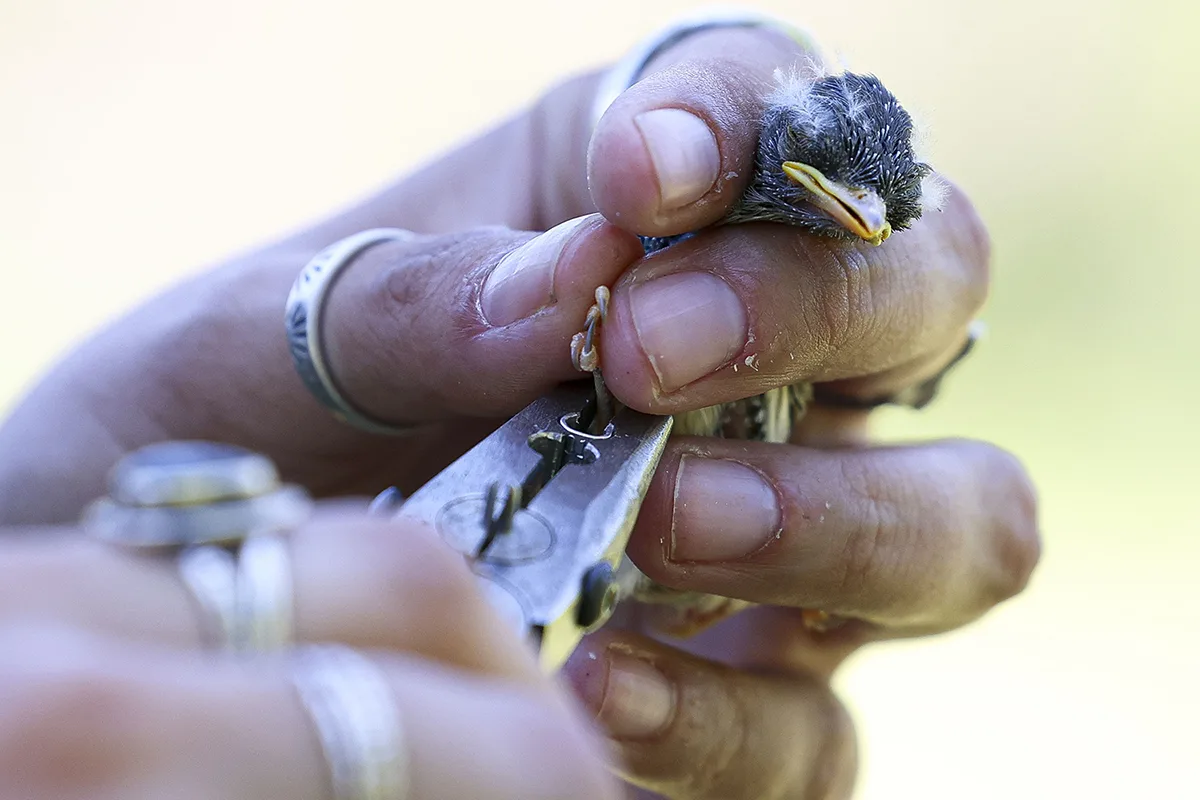By Libby Riddle, UM News Service
Photo: (UM photos by Ella Palulis)
ANACONDA – A nestling dusky flycatcher looks nothing like its sleek adult counterpart. Days old, its feathers grow in white tufts on either side of its head. It doesn’t make a sound even as University of Montana graduate student Mary Venegas carefully plucks it from the nest.
“One of the great things about studying baby songbirds is that at this age their nervous system hasn’t developed yet,” Venegas said. “They don’t have the instinct to be afraid, so they’re easier and safer to handle than adult birds.”
A graduate student in UM’s Wildlife Biology program and a longtime member of the university’s Bird Ecology Lab (UMBEL), Venegas is highly trained to handle these animals in their most vulnerable state. Her research is part of a larger effort to understand how historic mining activity continues to impact Montana’s wildlife, including nestling songbirds.
Venegas grew up in Venezuela, a country where even common birds are striking and colorful. She recalls watching blue-and-yellow macaws soar past the windows of her house in Caracas. But with her country in turmoil, she knew she would need to leave to pursue undergraduate studies in wildlife science.
“Through some kind of fate or whatever you want to call it, I found out about UM’s renowned Wildlife Biology program,” Venegas said. “I remember seeing pictures of the Oval and the M and thought that would be a beautiful place to study.”
After graduating from UM in 2019 with a B.S. in Wildlife Biology, Venegas landed an internship at one of UMBEL’s bird banding stations, where scientists tag birds with small aluminum bands so they can be identified if captured elsewhere.
“At that point I couldn’t tell you what an American Robin looked like,” Venegas said. “It was a steep learning curve, but I fell in love hard and fast. That happens to a lot of people when it comes to birds.”
After a few years working field jobs, Venegas returned to UMBEL and campus to conduct her master’s research on a landscape shaped by one of the most significant chapters in Montana’s mining history.
Forty years ago, Anaconda, Montana, was home to an active smelter operation. As the final step in the copper mining process, the smelter used high heat to separate valuable copper ore from unwanted materials. For nearly 100 years, lead, arsenic, zinc and other heavy metal contaminants evaporated from the top of the smelter bound to air particles, which were deposited onto the surrounding landscape by prevailing winds.
The Environmental Protection Agency designated Anaconda a Superfund site in 1983, along with Butte and the upper Clark Fork River. In the over 40 years since, remediation and restoration have been intense in residential areas, but the narrow gulches surrounding nearby Mount Haggin are more difficult to address.
“The geography here prevents you from bringing in heavy machinery to remove contaminated soil,” Venegas said, pointing out the steep slopes on either side of Cabbage Gulch. “So instead they’ve focused on erosion control – planting vegetation and putting in man-made structures that hold the soil in place – so it doesn’t erode into the waterways and spread contaminants to other areas. Before these efforts, the soil was nearly eroded down to the volcanic rock.”
The erosion concerns are the result of intense logging during Anaconda’s mining heyday.
“These gulches should be covered in lodgepole pine,” Venegas said. “But we had to build mine shafts and houses for miners. So we were logging everything.”
The combination of logging and smelter activity means that what little vegetation is available as habitat for nesting songbirds may be contaminated with heavy metals. The Natural Resource Damage Program, which funds Venegas’s research alongside Montana Fish, Wildlife and Parks (FWP), completed what remediation work they can in the area. Venegas’s work aims to find out whether it was enough.
Every day, Venegas and her team head out at dawn to search these hillsides and gulches for nesting songbirds. They keep their eyes and ears open for clues they are nearing a nest – a yellow warbler chipping an alarm call or a dusky flycatcher carrying sticks toward a stand of aspens. When her team finds a nest, they mark the GPS coordinates and put flagging nearby so they can find it later. Venegas or one of her technicians will check on the nest nearly every day until the eggs hatch.
“Baby birds are what we call ‘locally grown,’” Venegas said. “The adult bird is not going to go further than a few hundred meters to forage for food, so the nestlings are getting fed from their immediate surroundings. So when we find heavy metal contaminants in the babies, we know those came directly from the bugs which came directly from the soil of this area.”
When the nestling birds are old enough – five to 10 days old depending on the species – Venegas collects blood and fecal samples from them. Before the day gets too hot, Venegas will carefully remove each nestling from the nest. After taking several measurements, including weighing the bird, which tells her how much blood she’s allowed to safely take, she pricks a vein that runs along the inside of the bird’s wing. She collects the blood sample in a small tube, as well as any fecal material the bird has generously left on her gloved hand. She repeats the process with each nestling, and within 30 minutes the babies are snuggled back in their nest where they belong.
“One myth I’ll bust right now is that you will not keep a parent bird from its nest if you touch a nestling,” Venegas said. “Parents will consistently go back to the nest after we’ve handled the nestlings. The issue with handling is scent trails, so you don’t want to handle them too long or often and leave a scent that predators could follow. But the parents will never give up on their babies.”
Scent trails are only one of several bird safety considerations Venegas and her team always have in mind. Venegas must be at 100% all the time to make the best decisions for the birds and her data. In her words, no data point is worth jeopardizing a bird’s life – not when the point of the project is to help these species.
“The hard part is just balancing how to get enough data while keeping birds safe” she said. “But it’s never an option for them not to be safe.”
Venegas samples nestlings across several sites around Anaconda with varying levels of contamination. Back at the lab, the blood samples reveal heavy metal concentrations, while the fecal samples provide a diet analysis of what the nestlings were fed. Coupled with analyses of the birds’ nest success across these sites, these samples allow Venegas to piece together what’s happening on the landscape level and whether the presence of heavy metals is having impacts on breeding success or nestling health.
“Birds are great ecological indicators,” Venegas said. “Their abundance means you can go anywhere and see birds. You can have multiple species that tell you different stories depending on their behaviors or diets. They’re in a good position in the food chain that gives you an idea of what’s happening at the levels below them. And they’re cute – that’s another good reason to study them.”
The data collected from Anaconda’s nestlings will do more than reveal the health of local songbird populations – it will help agencies like NRDP and FWP understand if decades of restoration work had their intended effects on the landscape. Venegas’s work links heavy metal contamination to measurable impacts on wildlife, providing critical feedback for the land managers tasked with addressing the long-term impacts of mining.
“One of my hopes for this project is that it will help inform restoration efforts in this watershed and other watersheds,” Venegas said. “Maybe we need to revisit the plan for the area around Mount Haggin or simply apply this knowledge to other systems.”
Venegas also stressed the importance of this work for Montanans who live, work and recreate on these impacted landscapes.
“This project is not just about the wildlife we’re targeting,” she said. “It’s about the impacts of mining and metal contaminants, which affect all parts of the food chain, including us.”
Venegas’s research is one piece of a larger effort by UMBEL to investigate mining impacts on Montana’s terrestrial ecosystems. Prior research on mining impacts has largely focused on waterways, while the terrestrial component is rarely at the forefront. Several of UMBEL’s projects are investigating how mine wastes in soil and water move up the food chain and into terrestrial systems through birds like osprey and tree swallows.
As Montana continues to reckon with its mining past, projects like this one offer insights into how ecosystems respond decades later and help chart a path forward for future restoration.
“Mining is an ever-present activity of humans,” Venegas said. “We mine a lot and we will continue to do so, so understanding the impacts of those activities is super important for understanding our past, present and future.”



